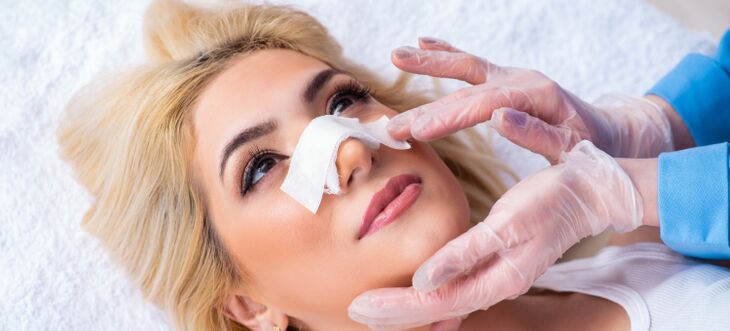
Recovery stage after rhinoplasty surgery
The day of rhinoplasty surgery
Phase 1 – The first 7 days after correction
Phase 2 - 7-14 days after plastic surgery
Stage Three - 2 weeks to 1 month after rhinoplasty
Stage 4 - 6 months to 1 year
What should patients pay special attention to during recovery?
- Do not remove or trim sutures yourself;
- Avoid mechanical impact on the nasal area;
- Treat the surgical site with antiseptic solution to prevent infection;
- When there is secretion, do not blow your nose and clean the nasal passages carefully with a sterile cotton swab;
- Sea salt solution is allowed to be used to rinse the nose.
Plastic surgeon's advice on speeding up and easing recovery
- After manual treatment, sleep on your back with the head of the bed elevated. This will increase the outflow of fluid from the head and make the swelling less obvious;
- Use a cold compress to reduce swelling - place the compress on the area next to your nose, not the organ itself;
- After the splint is removed, massage can be performed with the purpose of activating facial lymph nodes, thereby reducing swelling, improving blood supply and regeneration (active movements are not accepted, massage is done with gentle pressure with fingers, the principle is: "finger touch") "-" Light pressure 30Seconds"-"let go");
- To absorb hematoma faster, you can use special ointments recommended by your doctor.
Make an appointment with a plastic surgeon after surgery
- 7 days after operation;
- 1 month after intervention;
- Two months later;
- Within 3 months;
- within six months;
- Within a year.

using drugs
Nutrition and Diet
limit
- Active nose blowing - only careful cleaning of the nasal passages is allowed;
- Lying on your stomach and side - preferably on your back;
- Wear any eyeglasses, including corrective lenses, for at least 2 months;
- weightlifting and physical activity;
- Visit to solarium, hammam, sauna;
- Showering in extreme temperatures.
visible results
FAQ
When can I go to a solarium after surgery? UV exposure and thermal effects dilate blood vessels and capillaries, causing bleeding, increasing swelling, and slowing soft tissue regeneration. You can go to a solarium up to 6 weeks after rhinoplasty, when the hematoma has completely subsided and the edema syndrome has passed. When can I exercise after rhinoplasty surgery? Physical exercise causes an increase in heart rate and blood circulation, especially in the face, so all activities must be postponed for 2-3 months, and professional sports resumed - at least six months. When can I have sex after rhinoplasty surgery? Sexual life is a very important physical activity and should be avoided within the first 2-3 weeks after correction, otherwise bleeding and swelling may increase, and any slight contact with the nose will deform the organ and affect the final result. When can I take a shower after surgery? You can take a bath 3-5 days after correction, and the water should be warm. It is important to avoid getting the plaster cast wet; it must be kept dry as the first replacement may need to be done at least 5 days after use. When can I drink alcohol after surgery? All alcoholic beverages contain ethanol, which without exception slows tissue regeneration and negatively affects blood vessels and heart, so it is extremely important to abstain from alcohol for at least a month after surgery. How long will swelling last after surgery? Tissue swelling is standard after rhinoplasty. Swelling peaks approximately 3 days after correction, when swelling of the nose, eyelids, cheeks, and in some cases the chin is noticeable, and then gradually begins to subside. Significant symptoms disappear within 1-3 weeks. Residual compaction that is invisible to others will disappear after 6-8 months. How long after surgery can I go to a bathhouse? Within 2 months after rhinoplasty surgery, do not expose your body to strong heat or sudden changes in temperature. Therefore, you should avoid bathing, sunbathing (including solariums) and contrast showers during this period.




















